Gamebox 2.0: Games of August 2023
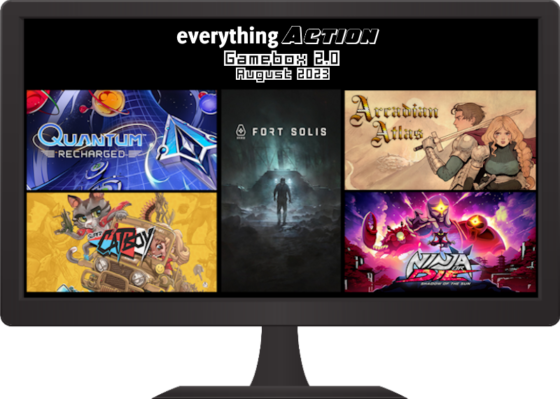
As the summer winds down, we’ve spent some of the last dog days of the season checking out new games for the latest Gamebox 2.0. We reviewed another reimagined Atari classic with Quantum: Recharged, tested our ninja abilities with Ninja or Die: Shadow of the Sun, raised a squadron of soldiers in Arcadian Atlas, and more! Check out everything we played this month below.
Quantum: Recharged (Zach): The latest remastered classic from Atari, Quantum: Recharged brings the 1982 arcade classic to the modern day. Although it seems at first glance like a shooter in the vein of Geometry Wars, Quantum: Recharged is more like that game’s “pacifist” mode mixed with a game like Qix. You control your ship and create enclosed shapes with the line trailing behind you to encircle and trap enemies. Any enemies inside the shape when it is completed or run into it after it gets formed get destroyed and the key to high scores is to combo and get as many enemies destroyed as possible in each enclosure. You have an acceleration button that lets you quickly close the distance and finish your shapes and the game also has a co-op mode, so two players can team up to destroy the various nuclear elements trying to destroy you.
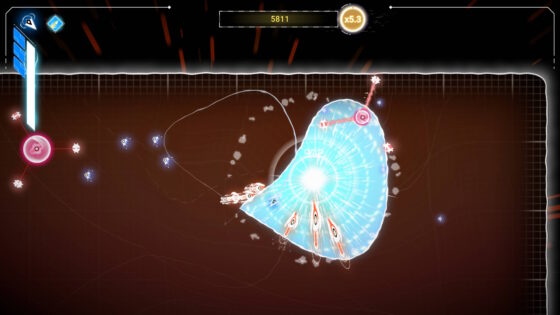
The game has some fast and furious action but it does take a bit to get used to the fact that you can’t shoot and to figure out the limits of the shapes you can make. Unlike Qix, there is a limit to the size of trap you can make but once you know your limits, you can weave in and out of the enemies and quickly swing around to capture them. The game builds to intense levels, with all kinds of different enemies showing up, some tracking you down and others striking from a distance with lasers.
You can compete in a traditional arcade mode, where you try to get the highest score possible before you die, or mission mode, which gives you different objectives to complete, like destroying all enemies. In arcade mode, you can turn on different modifiers that can make things harder or easier, but doing so will affect your score. There’s a “zen” mode that lets you play a 4-minute session without dying but your final score will be 50% of what it normally would be. The visuals have that great neon Geometry Wars style that all the “Recharged” series games have and the music from Meghan McDuffee is also fantastic, delivering a driving techno beat that builds the higher your score climbs. Whether you’re familiar with the original Quantum or not, Quantum: Recharged is a fantastic arcade experience that delivers something different from a “shooter” and is definitely worth checking out now on Switch, Playstation, Xbox, PC, and Atari VCS.
Super Catboy (Chris): A humanoid cat escapes from a mad scientist and teams up with a weapon-crazed human to stop the rise of an animal army in Pixelpogo and Assemble Entertainment’s Super Catboy. Taking elements from Megaman X, Donkey Kong Country, and Metal Slugs, this action platform features slick retro visuals with classic adventure mechanics. The player takes control of Catboy, a large size cat with sharp claws and a quick trigger toe.
Despite appearing that Catboy would have a ton of upgrades and interchangeable abilities, the core gameplay of Super Catboy keeps things very simple. There are no RPG elements that can make Catboy any stronger than he was after the initial levels. Catboy has short-range melee attacks and a handgun that needs ammo. However, the melees don’t change and the handgun cannot be upgraded in any way. The same goes for the Catboy’s maneuvers too. Catboy has the standard movements like a jump and wall slide. Then after one level, gains just a dash ability.
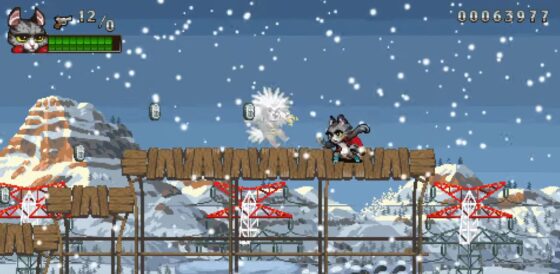
The game keeps everything balanced by keeping things very easy most of the time. There isn’t a ramp-up to the challenge factor with hard enemies or difficult-level design that needs Catboy to become more powerful. Ammo can be found in a lot of places. Health is scattered around levels and is dropped by enemies. There are a few tricky platforming spots that take a few attempts to understand, but nothing to really frustrate players.
The amazing sprites and colorful animations are what keep me playing. Pixelpogo definitely has an eye for smooth graphics that create a fun atmosphere. The game seems to be self-aware of its silly premise and there are some funny moments that the sprite animations heighten. The music is good and tries to match the theme of the level pretty well.
Super Catboy is on the short side and lacks the depth to make it really stand out in the gameplay department. However, the presentation is fun and is perfect for a quick session of gaming. This could have worked as a SNES title or even a handheld. The devs really did a good job making it seem like a lost title from the 90s in that sense. The nostalgia factor plays a big role in having players stay for the short run time. While this is something that doesn’t have to be played right away, Super Catboy is a title for fans who appreciate good sprite work. Super Catboy was released for PC on July 24th
Ninja or Die: Shadow of the Sun (Zach): Coming from Nao Games and Marvelous Europe, Ninja or Die: Shadow of the Sun brings some unique roguelite ninja action to PC. You play as a ninja pickpocket who gets thrown into a demonic world after a cataclysmic event hits Edo-era Japan. Trapped in a loop of death, you need to figure out what the mysterious force that transformed the world is and how to break its hold on you and the world. Although it seems like it would play something like The Messenger or similar games inspired by Ninja Gaiden and similar platformers, Ninja or Die has you using the analog stick (or mouse) and one button to move around. You cannot walk or move around normally. Instead, you aim where you want your ninja to jump toward and then press the button to leap in that direction. You can hold down the button to charge up and unleash a powerful jump that will send you higher and farther. Attacking is done by launching into enemies but you can also pick up different items and weapons that will let you attack in a different way but still using the stick to aim and button to activate.
It takes some getting used to, especially wrapping your mind around the fact that you can’t move or jump how you expect to and I do wish you had a little bit more control in mid-air or something like POINPY on phones where you get three jumps that you can use however you want, even mid-jump, but you have to land to refill them. Once you get your head around the movement, you can move around pretty quickly, which you’ll have to master for stages where there is a scrolling death wave coming after you, but this is definitely a game you can’t just jump into and immediately be good at.
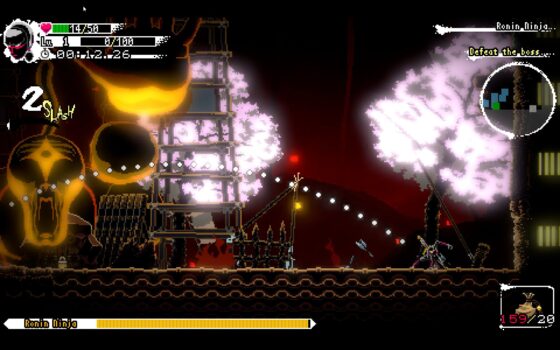
Being a rogue-lite, the game is played via runs where you try to progress as far as you can before dying. You build up experience each run, which you can use to purchase upgrades and skills that will help you progress further in the next run. Within the stages, you can find villagers who were also transported into the mysterious realm you are in and, if you find them, they will begin to populate the starter village and unlock new abilities and shops that you can utilize at the start of each run. The game has an awesome look that is pixel art but done in an extremely unique way that almost feels like a full-color version of old VGA/CGA graphics and the music is also suitably thumping and driving to keep the action moving. Ninja or Die is definitely a challenge to get the hang of but if you are up for it and enjoy rogue-lites, you can check it out now on Steam.
Arcadian Atlas (Chris): Two soldiers serving in a fractured kingdom are torn between duty and honor in Arcadian Atlas. Developed by Twin Otter Studios and published by Serenity Forge, Arcadian Atlas is a 2D tactical isometric RPG inspired by Final Fantasy Tactics. The story follows Vashti and Desmond, two star-crossed lovers and soldiers in the Arcadia kingdom. Their king falls ill, leaving their new Queen to rise to power. Queen Venezia begins to secure her position by declaring Princess Lucretia and her sister Princess Annalise as illegitimate heirs, stirring up conflicts across the land. Vashti and Desmond are ordered by the Queen to escort Princess Annalise to a nunnery. However, an encounter with the rebellious Princess Lucretia leads to strife in Vashti and Desmond’s bond. Alliances will be forged and friends will turn into enemies when people fight for what matters most.
While Vashti and Desmond are the main focus of Arcadian Atlas, the narrative elaborates on the backgrounds of many key characters. The game jumps from the present to the past multiple times to show details about Vashti and Desmond’s companions, Queen Venezia’s motives, and the princesses’ struggles. As the war between Queen Venezia and Princess Lucretia divides the nation, Vashti and Desmond are tasked with building up recruits to join the fight.
To keep the momentum of the plot, the game doesn’t use random chance encounters for battles. The game breaks up the narrative by having the player choose the next space on an overview map, which either sets up a main quest line or an optional mission. Battles are fought at fixed points in the story with enough details like a minimal level requirement to prepare for the upcoming battles. This greatly removes the demand for grinding for levels. Players can rely on smart tactics rather than being overpowered to win.
Combat follows the familiar tactical, grid-based system. The player and the enemy take turns to set up positions and attack. Each unit has a limited amount of action points to move, attack or defend. Depending on the job class, the unit can be utilized to attack from short or long-range with basic attacks or special skills. Attacks will be checked with extra defensive stats from the opposing unit and can even harm friendly units depending on the attack. You can’t use a lot of risky tactics since the player’s generic recruits have permadeath and the main characters that are defeated result in an instant loss. This encourages to deployment of a variety of units to create an even-level party and help lower-level units catch up.
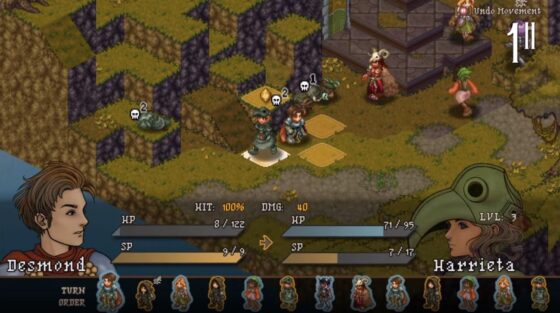
Arcadian Atlas has great retro sprite work for clean visual effects. There is practically no voice work in the cut scenes or battles, but it doesn’t take away from telling the emotional part of the interactions. The musical score plays a big hand in making battles feel intense and does not feature the typical orchestral soundtrack. Battles are fought with jazz and blues-inspired songs, which adds a causal and relaxing tone while the player does some tactical thinking. However, you’ll have to be relaxed and calm at times when navigating through the different menu systems, wishing there were shortcuts to instantly jump to actions quicker.
Overall, the presentation and the plot are enough to entertain players looking for a causal RPG. Arcadian Atlas offers a safe mix of fun things for newcomers and veterans to the genre. The gameplay could have been tweaked to take in more factors like battle terrain and unit elevation to affect combat more, but that would take away from more of the fast-paced combat system it is trying to focus on. Depending on the skill levels, players can typically spend 10 minutes or more to gain a good victory. Later parts offer bigger challenges and the risk of losing units, but it only takes another round of recruiting and training to regain losses. It doesn’t punish players for making too many mistakes but prepares the player enough to not feel overwhelmed with decisions. Arcadian Atlas was released July 27th for PC and a later release date for consoles.
Fort Solis (Zach): We checked out Fort Solis at PAX East earlier this year (and talked to star Roger Clark) and the full game is out now on PC and PS5. Coming from Dear Villagers, Fallen Leaf, Black Drakkar Games, Fort Solis is a sci-fi, narrative-driven thriller set on Mars. You play as Jack Leary (voiced by Roger Clark), one of the engineers on a mining base on Mars. When the Fort Solis station sends out a distress signal, Jack heads to the remote outpost to investigate but finds it seemingly abandoned. Jack has to make his way through the station and try to piece together what happened and if there is anyone left in the station. Although the setting and 3rd person perspective make it seem like it might be an action game in the vein of Dead Space, Fort Solis is more about the story and exploration. There are puzzles to solve and clues to find as you make your way further into the station. Along the way, Jack will find computer terminals and data drives that contain e-mails and video logs from the crew of Fort Solis, including medical officer Wyatt Taylor (voiced by Troy Baker), which helps to start to paint a picture of what happened.
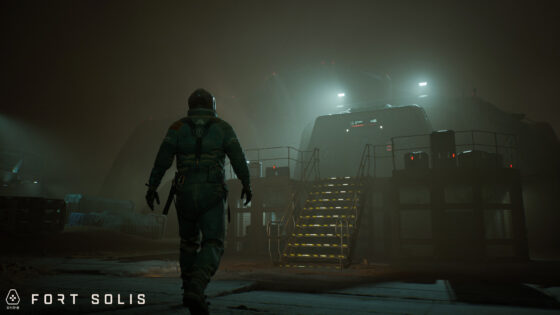
There’s no traditional platforming or combat but there are quick time events for when things start to ramp up. The game looks fantastic, with a creepy futuristic aesthetic to the Fort Solis station and it feels like a lived-in environment as you explore, poking into people’s bedrooms and different labs and offices. With Clark, Baker, and Julia Brown, who plays Jack’s partner, Jessica Appleton, it goes without saying that the voice acting is fantastic, with each actor giving their character tons of personality and life. The dynamic between Clark and Brown is especially great and there’s a great progression from joking around early on to getting more worried and serious as it seems like something really bad has gone on in Fort Solis.
The visuals are excellent with incredible lighting and detail, from the wind-whipped, dusty environment of the Mars surface to the various levels of Fort Solis. Along with trying to figure out the mystery of what happened, there are some collectibles that you can search for, like posters, so you are encouraged to explore every nook and cranny of the outpost. The game is divided into 4 chapters, each one about an hour or so in length, so the game is not particularly long but the developers encourage binging it like you would a Netflix series. I played the game via PS Plus’s hour trial program and I definitely reached what felt like a big shift into the second “episode” toward the end of the trial as things started to get creepy and dark. I’m definitely intrigued and eager to jump back in and if you’re looking for a sci-fi, narrative-focused experience with top-tier voice talent driving the story and characters, definitely check out Fort Solis on PS5 or PC.
